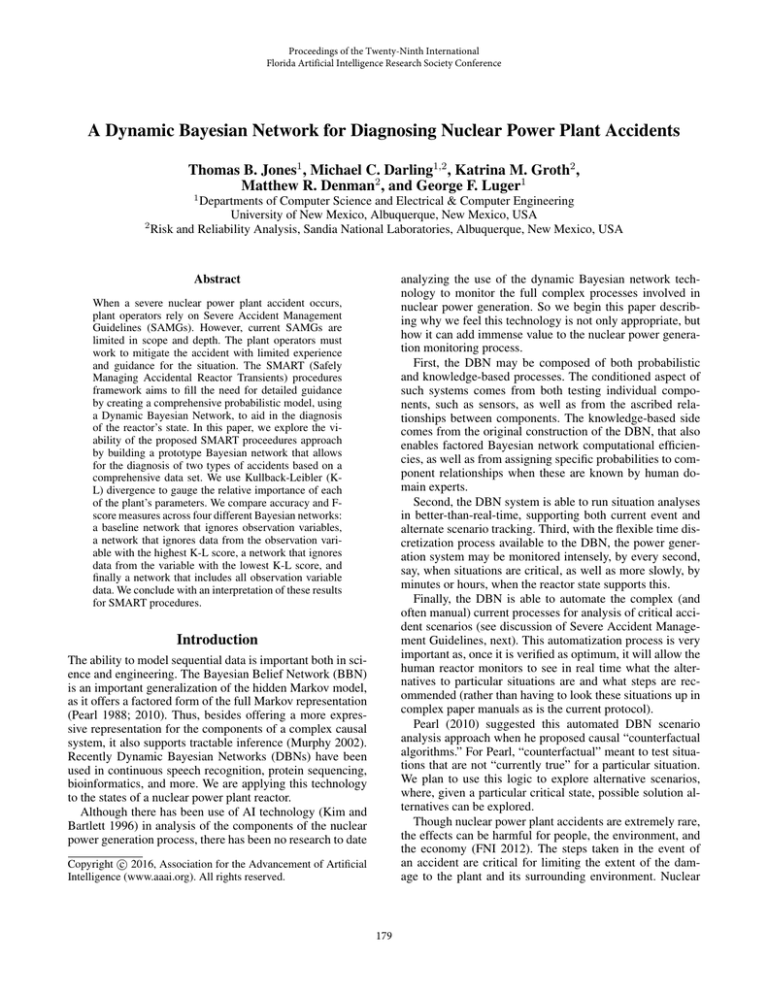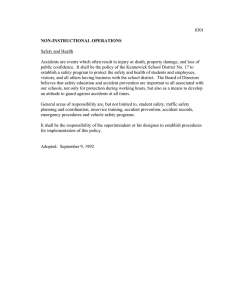
Proceedings of the Twenty-Ninth International
Florida Artificial Intelligence Research Society Conference
A Dynamic Bayesian Network for Diagnosing Nuclear Power Plant Accidents
Thomas B. Jones1 , Michael C. Darling1,2 , Katrina M. Groth2 ,
Matthew R. Denman2 , and George F. Luger1
1
Departments of Computer Science and Electrical & Computer Engineering
University of New Mexico, Albuquerque, New Mexico, USA
2
Risk and Reliability Analysis, Sandia National Laboratories, Albuquerque, New Mexico, USA
analyzing the use of the dynamic Bayesian network technology to monitor the full complex processes involved in
nuclear power generation. So we begin this paper describing why we feel this technology is not only appropriate, but
how it can add immense value to the nuclear power generation monitoring process.
First, the DBN may be composed of both probabilistic
and knowledge-based processes. The conditioned aspect of
such systems comes from both testing individual components, such as sensors, as well as from the ascribed relationships between components. The knowledge-based side
comes from the original construction of the DBN, that also
enables factored Bayesian network computational efficiencies, as well as from assigning specific probabilities to component relationships when these are known by human domain experts.
Second, the DBN system is able to run situation analyses
in better-than-real-time, supporting both current event and
alternate scenario tracking. Third, with the flexible time discretization process available to the DBN, the power generation system may be monitored intensely, by every second,
say, when situations are critical, as well as more slowly, by
minutes or hours, when the reactor state supports this.
Finally, the DBN is able to automate the complex (and
often manual) current processes for analysis of critical accident scenarios (see discussion of Severe Accident Management Guidelines, next). This automatization process is very
important as, once it is verified as optimum, it will allow the
human reactor monitors to see in real time what the alternatives to particular situations are and what steps are recommended (rather than having to look these situations up in
complex paper manuals as is the current protocol).
Pearl (2010) suggested this automated DBN scenario
analysis approach when he proposed causal “counterfactual
algorithms.” For Pearl, “counterfactual” meant to test situations that are not “currently true” for a particular situation.
We plan to use this logic to explore alternative scenarios,
where, given a particular critical state, possible solution alternatives can be explored.
Though nuclear power plant accidents are extremely rare,
the effects can be harmful for people, the environment, and
the economy (FNI 2012). The steps taken in the event of
an accident are critical for limiting the extent of the damage to the plant and its surrounding environment. Nuclear
Abstract
When a severe nuclear power plant accident occurs,
plant operators rely on Severe Accident Management
Guidelines (SAMGs). However, current SAMGs are
limited in scope and depth. The plant operators must
work to mitigate the accident with limited experience
and guidance for the situation. The SMART (Safely
Managing Accidental Reactor Transients) procedures
framework aims to fill the need for detailed guidance
by creating a comprehensive probabilistic model, using
a Dynamic Bayesian Network, to aid in the diagnosis
of the reactor’s state. In this paper, we explore the viability of the proposed SMART proceedures approach
by building a prototype Bayesian network that allows
for the diagnosis of two types of accidents based on a
comprehensive data set. We use Kullback-Leibler (KL) divergence to gauge the relative importance of each
of the plant’s parameters. We compare accuracy and Fscore measures across four different Bayesian networks:
a baseline network that ignores observation variables,
a network that ignores data from the observation variable with the highest K-L score, a network that ignores
data from the variable with the lowest K-L score, and
finally a network that includes all observation variable
data. We conclude with an interpretation of these results
for SMART procedures.
Introduction
The ability to model sequential data is important both in science and engineering. The Bayesian Belief Network (BBN)
is an important generalization of the hidden Markov model,
as it offers a factored form of the full Markov representation
(Pearl 1988; 2010). Thus, besides offering a more expressive representation for the components of a complex causal
system, it also supports tractable inference (Murphy 2002).
Recently Dynamic Bayesian Networks (DBNs) have been
used in continuous speech recognition, protein sequencing,
bioinformatics, and more. We are applying this technology
to the states of a nuclear power plant reactor.
Although there has been use of AI technology (Kim and
Bartlett 1996) in analysis of the components of the nuclear
power generation process, there has been no research to date
c 2016, Association for the Advancement of Artificial
Copyright Intelligence (www.aaai.org). All rights reserved.
179
power plant operators are given manuals with step-by-step
Emergency Operating Procedures to follow for each type
of anticipated accident. However, for unanticipated, beyonddesign-basis accidents there are Severe Accident Management Guidelines (SAMGs) which are developed from expert
judgments and best-estimates analyses. If the plants monitoring instruments fail, which was the case during 2011
Fukushima accident (FNI 2012), operators must act with
severely limited information about the current state of the
reactor.
In this paper, we present a prototype analysis tool for
a sodium fast reactor using the SMART (Safely Managing Accidental Reactor Transients) procedures framework
(Groth et al. 2014; 2015). This model would provide the
ability to diagnose the likely state of the reactor and also
provides insight into the relative diagnostic value of each
of the plant’s observed parameters. We explore the viability
of the SMART procedures framework with cross-validation
and the Kullback-Leibler divergence equation.
In order to gain an understanding of the possible responses of nuclear power plants during severe accidents, we
simulated accidents with various conditions using the nuclear reactor accident simulation software SAS4a (Cahalan,
Tentner, and Morris 1994). These simulations provide a rich
data set that can be used for training a supervised machine
learning algorithm. Using the simulated data, we built a dynamic Bayesian network in order to learn the conditions of
observed power plant parameters that can lead to Transient
Over Power and Loss Of Flow accidents. Transient Over
Power is an accident sequence that involves an unintended
increase in power. In a Loss of Flow accident the coolant circulation slows due to pump failure or an obstruction which
results in the core overheating.
In the following section we describe how our model was
developed and conditioned. We discuss the generation of
data through simulation of accident sequences, the creation
of the DBN, and demonstrate its interface. Then we evaluate
the performance of our Bayesian model through analysis of
the Kullback-Leibler divergence of its parameters, and analysis of the F-scores. Finally, we summarize our project and
suggest future research.
This understanding can enhance operators’ decision making
ability, especially during beyond-design-basis accidents.
Existing SAMGs rely on expert judgment and bestestimate analyses in order to capture the physical responses
of the plant. However, procedure developers cannot anticipate every possible accident scenario. This limitation can be
addressed with the use of Dynamic Probabilistic Risk Assessments coupled with Discrete Dynamic Event Trees to
provide comprehensive coverage of the potential accident
scenario space.
Dynamic Probabilistic Risk Assessment approaches can
explore thousands of accident scenarios that form the basis
for comprehensively learning the values of observable reactor parameters given known accident scenarios. This information provides a science-based support for operators especially during unanticipated accidents. These simulations
also take into account the possible actions of plant operators from the plant’s procedure manuals as parameters for
the simulation.
Discrete Dynamic Event Tree based software dynamically
branches the accident simulations whenever there is more
than one possible outcome. The result of this approach is a
comprehensive data set. However, the amount of data generated provides too much information to process during severe
accidents. Therefore, as a preprocessing step, we discretized
the data to allow for faster analysis.
Accident Data Generation and Processing
The data was generated for accident sequences using the
SAS4a liquid metal reactor simulator which performs deterministic analysis on nuclear accident scenarios. We ran
simulations with four target variables: the functional capacity of the nuclear power plant’s main coolant system (differential pressure), Direct Reactor Auxiliary Cooling System
(DRACS), the Balance of Plant (BOP) systems, and control
rod insertion (SCRAM). These systems, seen in Figures 2,
3, and Table 1, were chosen as target variables since compounded failures of these system have the potential to lead
to core damage.
The differential pressure parameter had three possible
states: 100%, 50%, and 0%. This variable describes the
capacity of the pumps removing heat from the core. The
DRACS parameter had three possible states: available, unavailable, and enhanced. Balance of Plant has three states:
operational, decay, and shutdown. The SCRAM parameter
had three states: control rods nominal, fully in, or fully out.
The control rods in a nuclear power plant are used to control
the fission rate. The SCRAM parameter describes the level of
the operators’ attempt at an emergency core shutdown. The
states of these target variables are initial conditions for the
simulations.
The results of the SAS4a simulations is data which is
comprised of 7189 distinct scenarios over a two hour simulation window each containing 2558 time steps. The simulations contain all possible combinations of target states that
would lead to significant deviations in accident progression.
Developing the DBN for Nuclear Reactors
Probabilistic Risk Assessments are used by the United States
Nuclear Regulatory Commission to quantify the causes,
likelihood, and consequences of nuclear accidents. Dynamic
Probabilistic Risk Assessment studies a system’s dynamics
often by employing reactor state simulators. These simulators can provide detailed insight into specific accidents, but
cannot yet be used to support real-time accident diagnosis.
The SMART Procedures framework involves creating a
dynamic Bayesian network based on dynamic probabilistic assessment of simulated nuclear accident data to provide
fast-running diagnostic support (Groth et al. 2014). This approach, as described in Figure 1, provides tools for diagnosing the likely state of a nuclear reactor given the values of the
observed plant parameters. This will potentially allow for a
greater understanding of the state of a reactor during accidents where only a subset of information might be available.
180
Figure 1: Risk-informed “Smart SAMG” development process for nuclear power plant diagnostic support Accident scenarios
(upper left) are generated using event trees, the scenarios are simulated with a system analysis program such as MELCOR or
SAS4a (bottom left), the data is used to generate a Bayesian network (upper right), the BN is analyzed using the GeNIe software
program to diagnose the reactor’s likely state (bottom right)
Discretization
bility of each of the observation variable states given each
combination of possible target variable states at each time
step.
With the conditional probabilities calculated, we then
constructed the BN. Our system reads a provided dynamic
BN outline which the user constructs with the GeNIe software. This pre-built BN contains a node for each of the
plant’s parameters, including the target and observation variables, and defines the relationships between them (see Figure 2). The observation variables, along with their states
are given in Table 1. The system then populates the model
with the conditional probabilities of each observation node
at each time step (see figure 3).
Besides providing an interface for constructing the
Bayesian network’s structure, GeNIe also provides a platform to analyze the BN by propagating evidence and diagnosing the states of the plant’s parameters. This functionality
can be used as a decision support system. Users can input a
set of known conditions, which would propagate evidence
to the unobserved target variables. The posterior probability can be used to predict the evolution of important reactor
systems.
The proper discretization of data values can improve the performance of supervised learning algorithms (Yang and Webb
2002). We discretized the conditional probability states of
each variable into equal width distributions. This binning
method calculates the maximum and minimum values for
each variable’s probability distribution and distributes the
values into k bins of equal width. We divided the probability
values for each variable into 3 bins.
Simulating nuclear power plant accidents with Discrete
Dynamic Event Trees allows for comprehensive modeling
of the nuclear accident space. However, due to the complexity of these models, they cannot be simulated and processed in real accident time. Therefore, the SMART procedures framework calls for the use of BNs to provide a means
to utilize the data for faster-than-real-time decision support
(Groth et al. 2014). Once built, the BN can be analyzed using the GeNIe (Druzdzel 1999) interface to inform the situational awareness of the operators (GeNie is a graphical interface to the University of Pittsburghs Structural Modeling,
Inference, and Learning Engine or SMILE).
Construction of The Bayesian Network
Model Performance
Each simulation offered a permutation of the initial conditions. These initial conditions were drawn from the Discrete
Dynamic Event Trees and were tied to a particular state of the
target variables. The resulting states of the observation variables — variables that could be discovered by an operator’s
instrumental observations — are returned by the SAS4a simulator. Using this data we calculated the conditional proba-
In this section we study the effectiveness and performance
of our DBN. In order to measure the pertinence of each of
the plant parameters, we implemented a variable evaluator
based on Kullback-Leibler (K-L) divergence (Cowell 2001).
K-L divergence measures the distance between two probability distributions (in this case, between two BN models). In
181
Figure 2: User-defined DBN Model Structure: the user creates the DBN model structure to define the relationships between
observation nodes, target nodes, and intermediate nodes. The oval-shaped nodes, which are placed on a temporal plate, represent
observed variables (the darker nodes are plant parameters observed in the control room, whereas lighter nodes are variables that
are not directly monitored). The rectangular nodes represent reactor systems. The light rectangular nodes on the far left are
targets representing the accident states. The system reads this hand-made model and populates its conditional probability tables
based on the data.
Figure 3: Unrolled DBN Model: the system creates a node for every time step. The model is now ready to be used to diagnose
the conditions which lead to Transient Over Power (TOP) and Loss Of Flow (LOF) accident states.
information theory, the Kullback-Leibler divergence equation is used to measure the amount of information lost when
the distribution function Q is used to approximate the actual
distribution function P :
P (i)
(1)
P (i)log
D(P ||Q) =
Q(i)
i
a large amount of information lost when a node is removed,
then the node is highly pertinent. If the information loss is
minimal, than the node may be unnecessary and thus a candidate to be pruned.
In calculating the K-L divergence of an arc in our BN,
P (i) is the model with the node that we were measuring
while Q(i) was the model without the node that we were
measuring. The values summed over i were combinations of
possible observed and target states. K-L divergence is calculated for each arc between the observation and target nodes
in a method similar to (Koiter 2006). Joint K-L divergence
calculations are conducted over all the target nodes for each
observation node. In calculating the joint K-L divergence,
we treated each combination of possible target states as a
single state in a joint target node that collected all targets
into a single node.
where P (i) represents the true probability distribution and
Q(i) represents a theoretical distribution. The equation defines divergence D between P and Q (i.e., the information
lost when Q(i) is substituted for P (i)).
In this study, K-L divergence is used to compare the BN
model that includes all of the plant parameters with BN
models that have removed one of the parameters. The divergence between two models shows how much information
was lost by the elimination of one of the variables. If there is
182
Figure 4: The accuracies and F-scores of all target variable states with varied data sets. The baseline value is when the most
frequent target combination is always chosen. Out of all the observed variables, t coolant and reactivity have the highest
and lowest K-L divergence values respectively. Evaluating the BN while dropping each of these variables from the data set
illustrates the change in performance of the BN’s predictive power. For all of the target variables, dropping reactivity has no
effect. Whereas removing the coolant temperature reduces the BN’s performance.
Cross-Validation
Table 1: The target variables and their states. Differential
pressure is the difference in pressure between the electromagnetic pumps. The SCRAM parameter indicates the operators attempting to control the core’s fission rate. Direct
Reactors Auxiliary Cooling System (DRACS) is the plant’s
emergency heat removal system. Balance of Plant (BOP)
consists of the systems that are not directly related to the
nuclear steam supply systems.
Target
States
Prior Probabilities
Operational 1.19×10−12
Balance
Shutdown
0.9999
Of Plant
Decay
3.97×10−13
0% flow
3e-13
Differential
50% flow
1.04×10−4
Pressure
100% flow
.9999
Fully In
0.0150
SCRAM
Nominal
0.985
Withdrawn 3.04×10−6
Enhanced
0.9850
DRACS
Operational 0.0150
Degraded
7.95×10−12
In any investigation of predictive models, cross-validation
is a standard technique to measure the predictive power of
a model while accounting for the possibility of an over-fit
model (Ng 1997). Our training set, however, was taken from
a spread of deterministically calculated simulations drawn
from a Discrete Dynamic Event Tree. Unlike data drawn
from a real source or random simulations, this data is representative of the real behavior of sodium reactor plants operating during beyond-design-basis accidents. It is our goal
to measure how well the Bayesian network models the results of the SAS4a simulation.
To do this we measured the F-score and accuracy of each
of the target variable states predicted by the Bayesian network when fed the discretized observation variable states
produced by the SAS4a simulator. The F-score is useful for
measuring the behavior of a machine learner on an asymmetric data set while the accuracy is generally used for symmetric data sets.
The results of the F-score and accuracy measurements can
be found in Figure 4. The figure shows the F-score of the BN
with full simulation data tends to outperform the baseline.
In a few cases, however, this is not the case — Specifically,
the F-score for DRACS operational and the SCRAM nominal state. Both of these states are the chosen state for the
baseline Bayesian network. This indicates that the Bayesian
network is occasionally incorrectly predicting that these two
states are not the correct state when they, in fact, are. This
is to be expected when moving from a static baseline that
always chooses the most likely target combination while ignoring the observation variables.
The accuracy of the DRACS operational and enhanced
After calculating the K-L divergence of each of the
observation variables we found that the coolant temperature (t coolant) had the highest K-L divergence value at
6.793×10−12 bits while reactivity had the lowest K-L divergence value at 3.234×10−18 bits. Thus out of all of the
observed variables, the t coolant and reactivity provide
the highest and lowest amount of information gain respectively.
183
states are the only states where the baseline guess is better than the BN with full observational data or observation
data with dropped variables. There were also a few places
where dropping the variable with the highest K-L divergence
value actually improved results in the BN. These included
two of the SCRAM states —- Nominal and Withdrawn in accuracy and the SCRAM nominal and BOP Decay on the Fscore. This points to the importance of choosing the correct
variables to predict the target accuracies on each of these
variables. The highest K-L variable, coolant temperature
(t coolant), was useful for predicting most variable states,
but it caused a decrease in accuracy and F-score for some
SCRAM and BOP states. The differences in these scores
shows how the Bayesian network compressed the SAS4a
simulation results.
ergy Advanced Reactor Technologies Program under work
package number AT-15SN200304.
References
Cahalan, J.; Tentner, A.; and Morris, E. 1994. Advanced lmr
safety analysis capabilities in the sassys-1 and sas4a computer codes. Technical report, Argonne National Lab., IL
(United States). Funding organisation: USDOE, Washington, DC (United States).
Clarke, E. J., and Barton, B. A. 2000. Entropy and
mdl discretization of continuous variables for bayesian belief networks. International Journal of Intelligent Systems
15(1):61–92.
Cowell, R. G. 2001. Conditions under which conditional independence and scoring methods lead to identical selection
of Bayesian network models. In Proceedings of the Seventeenth conference on Uncertainty in artificial intelligence,
91–97. Morgan Kaufmann Publishers Inc.
Druzdzel, M. J. 1999. SMILE: Structural modeling, inference, and learning engine and GeNIe: a development environment for graphical decision-theoretic models. In Proceedings of American Association for Artificial Intelligence
(AAAI-99), 902–903.
FNI. 2012. Investigation committee on the accident at
fukushima nuclear power stations. Technical report, Final
Report, July 23, 2012.
Groth, K. M.; Denman, M. R.; Cardoni, J. N.; and Wheeler,
T. A. 2014. ’Smart Procedures’: Using dynamic PRA to
develop dynamic, context-specific severe accident management guidelines (SAMGs). In Proceedings of the International Conference on Probabilistic Safety Assessment and
Management (PSAM 12).
Groth, K. M.; Denman, M. R.; Jones, T. J.; Darling, M. C.;
and Luger, G. F. 2015. Proof-of-concept accident diagnostic
support for sodium fast reactors. In European Safety and
Reliability Conference ESREL 2015, Zurich Switzerland.
Kim, K., and Bartlett, E. B. 1996. Nuclear power plant
fault diagnosis using neural networks with error estimation
by series association. Nuclear Science, IEEE Transactions
on 43(4):2373–2388.
Koiter, J. R. 2006. Visualizing inference in Bayesian networks. Master’s thesis, Delft University of Technology.
Murphy, K. P. 2002. Dynamic Bayesian networks: representation, inference and learning. Ph.D. Dissertation, University of California, Berkeley.
Ng, A. Y. 1997. Preventing “overfitting” of cross-validation
data. In ICML, volume 97, 245–253.
Pearl, J. 1988. Probabilistic reasoning in intelligent systems: networks of plausible inference. Morgan Kaufmann.
Pearl, J. 2010. Causality. Cambridge university press.
Yang, Y., and Webb, G. I. 2002. A comparative study of
discretization methods for naive-bayes classifiers. In Proceedings of PKAW, volume 2002. Citeseer.
Conclusions and Future Work
This paper presented a prototype system for diagnosing the
likely states of nuclear reactor systems. We simulated accidents with various conditions and used the resultant data to
build a dynamic Bayesian network in order to learn the conditions of observed power plant parameters that can lead to
Transient Over Power and Loss Of Flow Accidents. We also
used the Kullback-Leibler divergence equation in order to
gauge the relative importance of the plant’s parameters.
This study examines the viability of the Smart Procedures
Dynamic Probabilistic Risk Assessments methodology. This
framework provides tools to diagnose the likely state of a
nuclear reactor given the values of the observed plant parameters. This will potentially allow for a greater understanding
of the state of a reactor during accidents when only a subset
of information might be available. We also plan, based on
Pearl’s (2010) counterfactual analysis, to generate alternative paths forward, given a particular current state of the reactor. This understanding of possible alternative actions and
their consequences will enhance operators’ decision-making
ability, especially during beyond-design-basis accidents.
Our current system uses the most basic Bayesian network
techniques to capture the behavior of nuclear simulation results in a model that can be calculated in faster-than-real
time. While it shows promising results, as it improves performance over our baseline analysis, we must continue to
expand and calibrate the model parameters. In this paper we
presented a model that used Equal Width discritization of observation variables. In the future we plan to use Entropy or
dynamic Minimum Descriptive Length partitioning (Clarke
and Barton 2000) to discretize the observation variables.
Fine tuning variables so that only those that have the best
predictive power for each target is another important route
forward for this research.
Acknowledgements
Sandia National Laboratories is a multi-program laboratory
managed and operated by Sandia Corporation, a wholly
owned subsidiary of Lockheed Martin Corporation, for the
U.S. Department of Energys (DOE) National Nuclear Security Administration under contract DE-AC04-94AL85000.
This project was funded by the DOE Office of Nuclear En-
184






